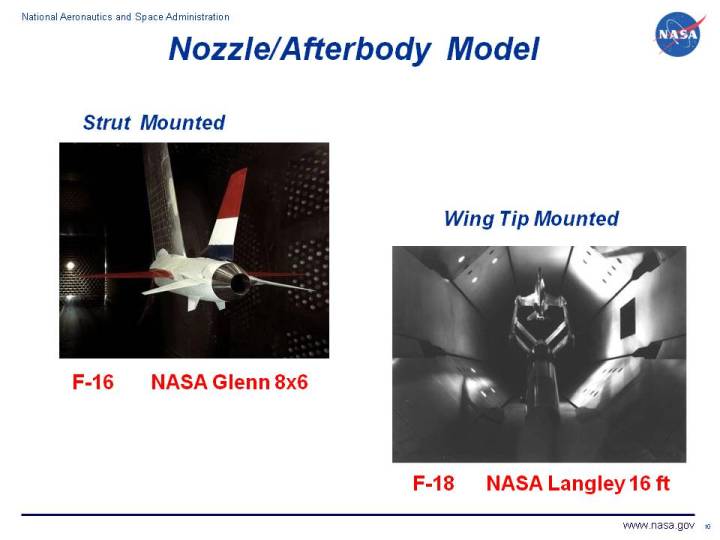
Aerodynamicists use
wind tunnels
to test models of proposed
aircraft and aircraft components. The model is placed in the
test section
of the tunnel
and air is made to flow past the model.
In some wind tunnel tests, the
aerodynamic forces
on the model are measured.
In some wind tunnel tests, the model is instrumented to provide diagnostic
information about the flow of air around the model. Model instrumentation
can include
static pressure taps,
tufts on the surface, or
total pressure rakes.
Some wind tunnel models are designed to determine the performance of a
particular component of the aircraft.
The aircraft
inlet and
nozzle
bring airflow into and out of the
gas turbine
propulsion system.
The performance of the inlet and nozzle depend on both the flight conditions of the aircraft
and the operation of the turbine engine. Special wind tunnel models are used
to determine the performance of the inlet
inlet
and the nozzle.
On this page we show two examples of nozzle performance wind tunnel models.
The model on the left is an F-16 nozzle model mounted in the NASA Glenn 8x6 foot
transonic tunnel. The model on the right is an F-18 twin-nozzle model mounted in the
NASA Langley 16 foot transonic tunnel.
There are several features that are unique
to nozzle/afterbody wind tunnel models. To properly model the flow exiting the nozzle,
high-pressure gas must be brought into the model and discharged through the
nozzle. On some models, the aerodynamic effects of the changing
nozzle pressure ratio
on afterbody drag is measured by putting some portion of the afterbody model on
a balance.
Propulsion systems for fighter aircraft like the F-16 and F-18 usually employ
afterburning
to produce additional thrust. During afterburning operation, the nozzle area must be
increased in order to pass the engine
mass flow rate
at the higher temperatures in the nozzle. The nozzle/afterbody wind tunnel model
must therefore employ several nozzles with different external areas to correctly
simulate the geometry of the aircraft. The nozzle on the F-16 model in the figure
is the configuration used in military power, without afterburner operation. An additonal
nozzle model is required for the full afterburner configuration.
Some modern fighter aircraft use
vectored thrust
to increase aircraft performance. The thrust vector is varied by changing the shape of
the nozzle in flight. Again, the various configurations must be wind tunnel tested to
determine performance.
Navigation ..


- Beginner's Guide Home Page
|
